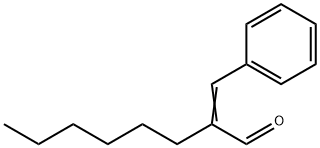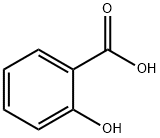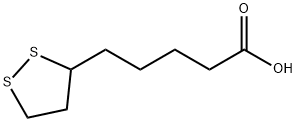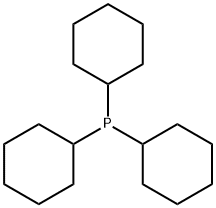alpha-Hexylcinnamaldehyde
Synonym(s):alpha-Hexylcinnamaldehyde;Hexyl cinnamal;Hexyl cinnamic aldehyde
- CAS NO.:101-86-0
- Empirical Formula: C15H20O
- Molecular Weight: 216.32
- MDL number: MFCD00006989
- EINECS: 202-983-3
- SAFETY DATA SHEET (SDS)
- Update Date: 2024-12-18 14:07:02

What is alpha-Hexylcinnamaldehyde?
Description
α-Hexylcinnamaldehyde has a jasmine-like odor, particularly on dilution. May be synthesized by condensation of octylaldehyde with benzaldehyde.
Description
2-Hexylcinnamaldehyde, colloquially “hexyl cinnamal” and formally 2-(phenylmethylene)octanal, is a fragrance ingredient used in perfumes and personal-care products. By itself, it has a jasmine-like odor.
2-Hexylcinnamaldehyde occurs naturally in chamomile oil, but almost all of the commercial product is synthesized via a reaction between octanal and benzaldehyde. An antioxidant such as 2,6-di-tert-butyl-4-methoxyphenol (“butylated hydroxyanisole”) is usually added as a preservative.
In 2017, the Unilever conglomerate based in London, UK, and Rotterdam, The Netherlands, announced that it would disclose the fragrance ingredients—including 2-hexylcinnamaldehyde—in ≈1100 of its products. The project was completed this past January. Consumers can view the ingredients in Unilever products at its smartlabel.org Web site.
Chemical properties
Pale-yellow liquid; jasminelike odor, particularly on dilution. Soluble in most fixed oils and in mineral oil; insoluble in glycerol and in propylene glycol.
Chemical properties
alpha-Hexylcinnamaldehyde is a yellow liquid with a mild, slightly fatty, floral, somewhat herbal odor, and a distinct jasmine note. Similarly to the ??-amyl homolog, ??-hexylcinnamaldehydemust be protected against oxidation by the addition of stabilizers. It is prepared in a manner similar to that of ??-amylcinnamaldehyde by alkaline condensation of excess benzaldehyde with octanal (instead of heptanal). ??-Hexylcinnamaldehyde is widely used in flower compositions (e.g., jasmine and gardenia) and, because of its stability to alkali, in soap perfumes.
Chemical properties
Hexyl cinnamaldehyde has a jasmine-like odor, particularly on dilution.
Occurrence
Reported found in cooked, scented rice.
The Uses of alpha-Hexylcinnamaldehyde
α-Hexylcinnamaldehyde is characterized by a typical floral scent, which makes them suitable to be used as fragrances in personal care (perfumes, creams, shampoos, etc.) and household products. It has been also used as flavouring additive in food and pharmaceutical industry.
The Uses of alpha-Hexylcinnamaldehyde
hexyl cinnamal is also known as hexyl cinnamic aldehyde. It is a fragrance that provides a floral, jasmine-like scent.
Definition
ChEBI: A member of the class of cinnamaldehydes carrying a hexyl substituent at the alpha-position.
Preparation
By condensation of octylaldehyde with benzaldehyde
Taste threshold values
Taste characteristics at 5 ppm: sweet, waxy, floral, green, citrus and fruity nuances
General Description
Solubilization of α-hexylcinnamaldehyde by the ionic surfactants, sodium dodecyl sulfate and dodecyltrimethylammonium chloride and a non-ionic surfactant such as dodecyl polyoxyethylene ethers has been investigated.
Hazard
Combustible.
Contact allergens
Hexyl cinnamic aldehyde is a fragrance allergen. Its presence has to be mentioned by name in cosmetics within the EU.
Solubility in organics
Insoluble in Propylene glycol and Glycerin. Soluble in alcohol, miscible with oils.
Properties of alpha-Hexylcinnamaldehyde
| Melting point: | 39 oc |
| Boiling point: | 174-176 °C/15 mmHg (lit.) |
| Density | 0.95 g/mL at 25 °C (lit.) |
| refractive index | n |
| FEMA | 2569 | ALPHA-HEXYLCINNAMALDEHYDE |
| Flash point: | 200 °F |
| storage temp. | -20°C |
| solubility | water: soluble0.005g/L at 25°C |
| appearance | pale yellow liquid or solid |
| form | Oil |
| color | Clear Yellow |
| Odor | at 100.00 %. fresh floral green jasmin herbal waxy |
| JECFA Number | 686 |
| Stability: | Hygroscopic |
| CAS DataBase Reference | 101-86-0(CAS DataBase Reference) |
| NIST Chemistry Reference | Octanal, 2-(phenylmethylene)-(101-86-0) |
| EPA Substance Registry System | .alpha.-Hexylcinnamaldehyde (101-86-0) |
Safety information for alpha-Hexylcinnamaldehyde
| Signal word | Warning |
| Pictogram(s) |
 Exclamation Mark Irritant GHS07  Environment GHS09 |
| GHS Hazard Statements |
H317:Sensitisation, Skin H410:Hazardous to the aquatic environment, long-term hazard |
| Precautionary Statement Codes |
P261:Avoid breathing dust/fume/gas/mist/vapours/spray. P272:Contaminated work clothing should not be allowed out of the workplace. P273:Avoid release to the environment. P280:Wear protective gloves/protective clothing/eye protection/face protection. P302+P352:IF ON SKIN: wash with plenty of soap and water. P333+P313:IF SKIN irritation or rash occurs: Get medical advice/attention. |
Computed Descriptors for alpha-Hexylcinnamaldehyde
alpha-Hexylcinnamaldehyde manufacturer
New Products
(S)-3-Aminobutanenitrile hydrochloride 4-Methylphenylacetic acid N-Boc-D-alaninol N-BOC-D/L-ALANINOL Tert-butyl bis(2-chloroethyl)carbamate 3-Morpholino-1-(4-nitrophenyl)-5,6-dihydropyridin- 2(1H)-one Furan-2,5-Dicarboxylic Acid Tropic acid 1-Bromo-3,5-Di-Tert-Butylbenzene S-2-CHLORO PROPIONIC ACID ETHYL ISOCYANOACETATE 2-Bromo-1,3-Bis(Dimethylamino)Trimethinium Hexafluorophosphate 4-IODO BENZOIC ACID 3-NITRO-2-METHYL ANILINE 1-(2,4-DICHLOROPHENYL) ETHANAMINE (2-Hydroxyphenyl)acetonitrile 4-Bromopyrazole 2-(Cyanocyclohexyl)acetic acid 4-methoxy-3,5-dinitropyridine 1-(4-(aminomethyl)benzyl)urea hydrochloride 2-aminopropyl benzoate hydrochloride diethyl 2-(2-((tertbutoxycarbonyl)amino) ethyl)malonate tert-butyl 4- (ureidomethyl)benzylcarbamate Ethyl-2-chloro((4-methoxyphenyl)hydrazono)acetateRelated products of tetrahydrofuran








You may like
-
 101-86-0 Hexyl Cinnamic Aldehyde 98%View Details
101-86-0 Hexyl Cinnamic Aldehyde 98%View Details
101-86-0 -
 101-86-0 98%View Details
101-86-0 98%View Details
101-86-0 -
 Hexylcinnamaldehyde 95.00% CAS 101-86-0View Details
Hexylcinnamaldehyde 95.00% CAS 101-86-0View Details
101-86-0 -
 α-Hexylcinnamaldehyde, 90% CAS 101-86-0View Details
α-Hexylcinnamaldehyde, 90% CAS 101-86-0View Details
101-86-0 -
 α-Hexylcinnamaldehyde CAS 101-86-0View Details
α-Hexylcinnamaldehyde CAS 101-86-0View Details
101-86-0 -
 alpha-Hexylcinnamaldehyde 99%View Details
alpha-Hexylcinnamaldehyde 99%View Details
101-86-0 -
 2 4 Dichloro Acetophenone CAS 101-86-0View Details
2 4 Dichloro Acetophenone CAS 101-86-0View Details
101-86-0 -
 α-Hexylcinnamaldehyde CAS 101-86-0View Details
α-Hexylcinnamaldehyde CAS 101-86-0View Details
101-86-0